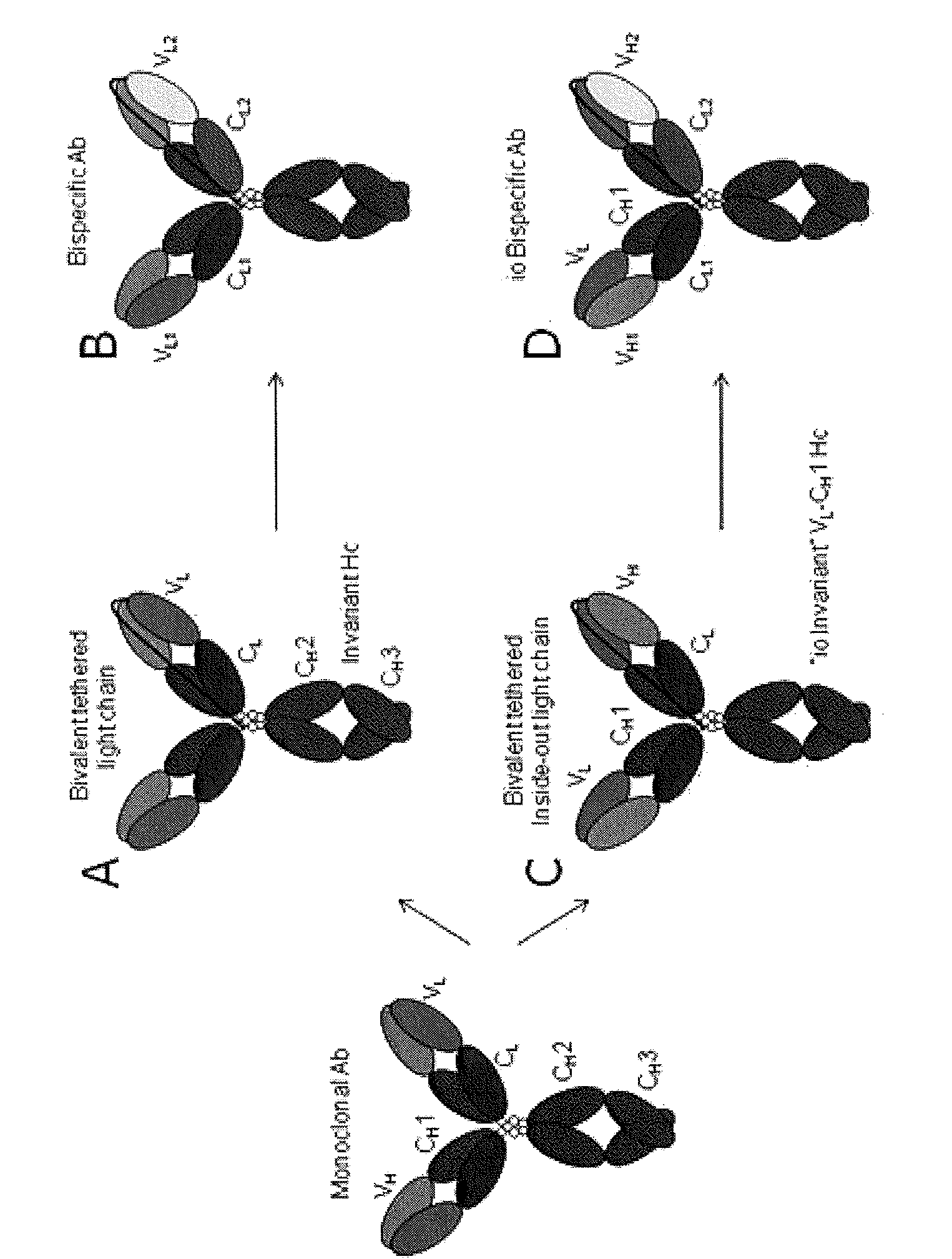Binding proteins having tethered light chains
a technology of light chain and binding protein, which is applied in the field of binding proteins having tethered light chains, can solve the problems of reduced serum half-life, increased propensity to elicit an undesired immune response, and lack of effector function
- Summary
- Abstract
- Description
- Claims
- Application Information
AI Technical Summary
Benefits of technology
Problems solved by technology
Method used
Image
Examples
example 1
Tethered Light Chain Binding Proteins
[0095]Two OSML186 light chains derived from an anti-oncostatin M antibody OSMM55 were tethered together via an extended, unstructured linker to be co-expressed and assembled with a heavy chain OSMH14 derived from the same antibody to form functional binding proteins. Similarly, two OSML178 light chains from an anti-oncostatin M antibody OSMM69 were tethered together and co-expressed with a heavy chain OSMH17 derived from the same antibody). Four different lengths of linkers were tested for each tethered light chain: (G4S)4 (SEQ ID NO: 1), (G4S)6 (SEQ ID NO: 2), (G4S)8 (SEQ ID NO: 3), and (G4S)10 (SEQ ID NO: 4), for their ability to promote optimal antibody assembly (lack of higher order “polymers”), binding and function as compared to parent antibodies with untethered light chains. Table 2 shows the binding proteins made and their light and heavy chain origins. The tethered light chains were of human Igκ and the heavy chains of human IgG1 type. T...
example 2
Inside-Out and Inside-Out Tethered Light Chain Containing Binding Proteins
[0099]Inside-out light and heavy chains and inside-out tethered light chains were generated to evaluate their assembly into functional binding proteins and retention of their characteristics when compared to parent antibodies from which the variable regions originated from.
[0100]Inside-out antibodies were generated by V region exchange e.g exchange of VL and VH regions between the heavy and the light chain of a parental antibody.
[0101]For example, binding protein BISM7 was generated by replacing the VH region of the parental antibody heavy chain (TF7H16VH) with the VL region of the parental antibody light chain (TF7L2VL) to generate an inside-out heavy chain, and the VL region of the parental antibody light chain (TF7L2VL) was replaced with the VH region of the parental antibody (TF7H16VH) to generate inside-out light chains.
[0102]The tethered inside-out light chains were generated by operably linking two iden...
example 3
Bispecific Inside-Out Tethered Light Chain Binding Proteins
[0105]Bispecific binding proteins were generated by co-expressing a tethered inside-out light chain having two inside-out variable regions with different antigen specificity with an inside-out heavy chain. Anti-mouse tissue factor antibody MTFM27 specifically binds mouse tissue factor but does not cross-react with human ortholog, and an anti-human TF antibody TF7M58 specifically binds human TF but shows no binding to mouse TF. A tethered inside-out bispecific light chain was generated by operably linking MTFM27 VH domain to human Cκ and TF7M58 VH domain to human Cκ, and the two inside-out light chains were operably linked using a (G4S)6 linker Parental antibodies MTFM27 and TF7M58 share an identical light chain (TF7L2), and thus only one inside-out heavy chain was generated by joining the VL of antibody TF7M58 to human IgG1 constant region. The generated light and heavy chains were co-expressed, and the resulting bispecific ...
PUM
| Property | Measurement | Unit |
|---|---|---|
| dissociation constant | aaaaa | aaaaa |
| dissociation constant | aaaaa | aaaaa |
| dissociation constant | aaaaa | aaaaa |
Abstract
Description
Claims
Application Information
 Login to View More
Login to View More - R&D
- Intellectual Property
- Life Sciences
- Materials
- Tech Scout
- Unparalleled Data Quality
- Higher Quality Content
- 60% Fewer Hallucinations
Browse by: Latest US Patents, China's latest patents, Technical Efficacy Thesaurus, Application Domain, Technology Topic, Popular Technical Reports.
© 2025 PatSnap. All rights reserved.Legal|Privacy policy|Modern Slavery Act Transparency Statement|Sitemap|About US| Contact US: help@patsnap.com

